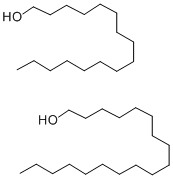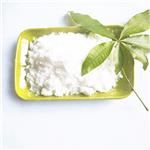Description
Cetostearyl alcohol (synonyms: cetearyl alcohol, cetyl stearyl alcohol; CAS No. 8005-44-5 and 67762-27-0) is a mixture of saturated fatty alcohols. It contains 65 to 80% stearyl alcohol (C18H37OH, 1-octadecanol) and 20 to 35% cetyl alcohol (C 16H33OH, 1-hexadecanol). The European Pharmacopoeia requires a content of stearylalcohol not less than 40% and that the sum of the contents of cetyl alcohol and of stearylalcohols is not less than 90%. Cetostearylalcohol is obtained by reduction of the appropriate fatty acids in coconut oil and palm kernel oil. Cetostearylalcohol is also a natural component in whale oil (spermaceti).
Chemical Properties
Cetearyl alcohol is a white or pale yellow, wax-like mass, plates, flakes or granules that is a combination of cetyl and stearyl alcohols, which occur naturally in plants and animals.
Physical properties
Cetearyl alcohol has emulsifying and stabilizing properties, and is also known as cetylstearyl alcohol and Lanette O. It is essentially a mixture of two long‐chained stereoisomers, cetyl and stearyl alcohol. These alcohols are components of lanolin.
Occurrence
Cetearyl alcohol is widely used in steroid creams, emollients and cosmetics. Sometimes only one of the stereoisomers is used. It is a component of emulsifying wax and therefore found in emulsifying ointment and aqueous cream BP.
Cetearyl alcohol is used to help soften the skin and hair and to thicken and stabilize cosmetic products, like lotions and hair products. As an emollient, cetearyl alcohol is considered an effective ingredient for soothing and healing dry skin. Products with cetearyl alcohol: skin lotions, moisturizers, skin creams, sunscreen, shampoo, conditioners, hair removal creams, hair mousse, anti-frizz hair cream, hair dye,mascar.
Uses
cetearyl alcohol (cetostearyl alcohol) is an emulsifying and stabilizing wax produced from the reduction of plant oils and natural waxes. Also used as an emollient and to give high viscosity to a finished product. Cetearyl alcohol is a mixture of fatty alcohols consisting primarily of cetyl and stearyl alcohols.
Cetearyl alcohol (cas# 67762-27-0) is a fatty alcohol which is understood to cause contact dermatitis. Ceteryl alcohol also appears in the preparation of solid lipid nanoparticles, nanostructured lipid carriers and nanoemulsion of lornoxicam for transdermal delivery.
Production Methods
Cetearyl alcohol is a combination of cetyl and stearyl alcohols. Stearyl alcohol is manufactured by transesterification and distillation of coconut or palm kernel oil using a methanol and a zinc catalyst, followed by hydrogenating the resulting methyl esters using a copper catalyst. The catalysts are removed during the fractional distillation phases, so there are little or no metals in the final product.Cetyl alcohol is manufactured by reducing ethyl palmitate (the waxy ester of palmitic acid) with metallic sodium and alcohol or under acidic conditions with lithium aluminum hydride as a catalyst.The final product melts at a temperature higher than that of the human body, which makes it useful for makeup and other things that are warmed by the skin.
Health Hazard
When used in skin care, cetearyl alcohol is completely safe for skin! Although some alcohol for skin can definitely be drying and irritating, fatty alcohols like cetearyl alcohol are the opposite. In fact, they help nourish and moisturize the skin and help give cosmetics their consistency (otherwise, you’d have a big, gloopy, gloppy mess in every jar!).
The Cosmetic Ingredient Review (CIR) Expert Panel concluded in 1988 that fatty alcohols, including cetearyl alcohol, are safe for use in cosmetic products. A subsequent 2005 review confirmed these results.
In clinical studies, cetearyl alcohol was found to have no significant toxicity and was non-mutagenic.
Flammability and Explosibility
Non flammable




